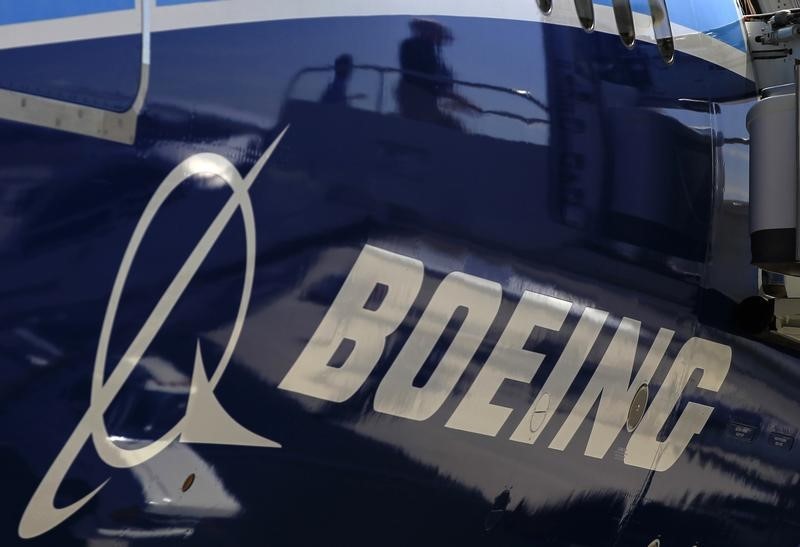(Reuters) -Boeing Co CEO Dave Calhoun and commercial airplanes head Stan Deal will step down in a management shake-up that follows intense regulatory scrutiny into safety issues with its top-selling 737 MAX jets.
The FAA had temporarily grounded 171 Boeing (NYSE:) 737 MAX 9 planes after a panel flew off an Alaska Airlines jet shortly after takeoff on Jan. 5.
Here is what regulators and airlines are doing as a result of the incident:
AIRLINES WITH THE AFFECTED PANEL:
ALASKA AIRLINES
The airline grounded all 65 of its Boeing 737 MAX 9 planes and cancelled hundreds of flights after the incident.
It said on Jan. 8 that initial reports from its technicians indicated some “loose hardware” was visible on some aircraft in the relevant area.
Fifty-seven of 65 grounded Alaska Airlines jets have resumed flying as of Feb. 5, according to the FAA. Alaska Airlines had said it expected inspections to be completed over the course of the following week after the FAA gave the green light to the resumption of MAX 9 flights.
UNITED AIRLINES
The only other U.S. airline operating the jets that suspended service on all 79 of its 737 MAX 9 aircraft.
The carrier said on Jan. 8 its preliminary checks found bolts that needed tightening on several panels.
After receiving final approval from the FAA to complete the process to return its 79 MAX 9 fleet to service, 78 of the 79 United Airlines have returned to flying as of Feb. 5, according to the FAA.
The company has 100 MAX deliveries scheduled for this year, according to a regulatory filing in October.
COPA AIRLINES
The Panamanian carrier said on Jan. 9 that 21 Boeing 737 MAX 9 planes remained grounded while authorities and the manufacturer defined inspection instructions.
AEROMEXICO
The airline said on Jan. 12 that the 19 Boeing 737 MAX 9 jets in its fleet remained grounded awaiting inspection.
Aeromexico added it had launched a flexible flight-change policy for affected travellers, but did not specify how many flights had been cancelled.
TURKISH AIRLINES
The airline said on Jan. 7 it had withdrawn five 737 MAX 9 aircraft from service for inspection.
REGULATORS:
U.S. FEDERAL AVIATION ADMINISTRATION (FAA)
The FAA allowed MAX 9 planes to resume flying after inspections were completed. It said on Feb. 5 that nearly all planes had been inspected and returned to service since the emergency. The regulator had launched a formal investigation into the aircraft on Jan. 11.
In an unprecedented move that came with the approval to return planes to service in January, the FFA had also barred Boeing from expanding production, following “unacceptable” quality issues.
An expert panel the administration appointed to review the planemaker’s safety management processes found on Feb. 26 a “disconnect” between Boeing’s senior management and employees on safety culture.
The report was directed by the U.S. Congress originally after two fatal Boeing 737 MAX crashes in 2018 and 2019 that killed 346 people. The door panel blowout “amplified the expert panel’s concerns.”
U.S. NATIONAL TRANSPORTATION SAFETY BOARD (NTSB)
The independent U.S. agency opened an investigation into the incident, and it appointed International Associations of Machinists and Aerospace workers (IAM) to the investigation.
On Feb. 6 it released a report that said that a door panel that flew off a Boeing 737 MAX 9 jet mid-flight on Jan. 5 appeared to be missing four key bolts.
The door plug panel was manufactured by Spirit AeroSystems (NYSE:), a former Boeing subsidiary, NTSB said. It had arrived at Boeing’s assembly plant in Renton, Washington on Aug. 31, 2023.
The report shows the panel had to be removed at Boeing’s factory before being reinstalled.
Previously, the NTSB had also said the plane’s cockpit voice recorder was overwritten, renewing long-standing calls for longer in-flight recordings.
BRAZIL
Brazil’s aviation regulator ANAC said on Jan. 7 the FAA ruling automatically applies to all flights in Brazil.
In Brazil, only Copa Airlines operates the plane, it said.
BRITAIN
The UK Civil Aviation Authority said on Jan. 6 that no UK-registered planes were affected. It will require any 737 MAX 9 operators entering its airspace to comply with the FAA directive.
CHINA
Chinese airlines do not have the MAX 9 model in their fleet, only MAX 8 which do not have the panel involved in the Alaska Airlines incident.
China’s foreign ministry said on Jan. 25 that Boeing has permission to resume deliveries of its 737 MAX 8 to Chinese customers as authorities completed a design approval of the aircraft.
EUROPEAN UNION
The EU Aviation Safety Agency (EASA) adopted the FAA directive, but noted no EU member state airlines operate aircraft with the affected configuration.
INDIA
India’s Directorate General of Civil Aviation (DGCA) said on Jan. 8 that one-time inspections it had ordered of 737 MAX 8 aircraft had been performed satisfactorily. None of the country’s airlines fly the MAX 9 model.
INDONESIA
Indonesia temporarily grounded three MAX 9 planes operated by Lion Air on Jan. 6, a transport ministry spokesperson said, adding that the planes had different configurations from the Alaska Airlines plane.
PANAMA
Panama’s civil aviation authority said on Jan. 11 it had grounded 21 of Copa Airlines’ 737 MAX 9 planes. The carrier has 29 in its fleet, but only 21 have the affected panel.
SOUTH KOREA
South Korea’s transport ministry said on Jan. 11 it will conduct inspections of maintenance procedures of the country’s airlines operating 737 MAX 8 aircraft.
The ministry said five South Korean airlines operate 14 MAX 8 airplanes. This comes after the ministry said no problems had been detected after inspections on Jan. 9.
TURKEY
Turkey’s Directorate General of Civil Aviation on Jan. 8 noted the FAA’s actions and said it was coordinating with stakeholders regarding affected aircraft belonging to airlines in Turkey and those using Turkish airspace.
UNITED ARAB EMIRATES
The civil aviation said on Jan. 7 that none of its national carriers have planes affected by the order.
Read the full article here
